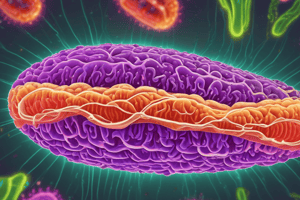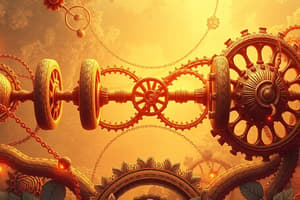Podcast
Questions and Answers
What is the ultimate 'electron sink' that drives the oxidation reactions in the electron transport chain?
What is the ultimate 'electron sink' that drives the oxidation reactions in the electron transport chain?
- FADH+
- NADH
- CO2
- Molecular O2 (correct)
Which organelle is the main site of ATP synthesis?
Which organelle is the main site of ATP synthesis?
- Lysosome
- Mitochondria (correct)
- Endoplasmic Reticulum
- Golgi Apparatus
What is the purpose of the Proton Motive Force (PMF) generated by the electron transport chain?
What is the purpose of the Proton Motive Force (PMF) generated by the electron transport chain?
- Enhancing the production of CO2
- Promoting the formation of NADH
- Facilitating the breakdown of glucose
- Driving the synthesis of ATP (correct)
Which part of the mitochondria is impermeable to most molecules except those with specific transporters or channels?
Which part of the mitochondria is impermeable to most molecules except those with specific transporters or channels?
What are the high energy electrons carried by to generate a proton H+ gradient across the inner mitochondrial membrane?
What are the high energy electrons carried by to generate a proton H+ gradient across the inner mitochondrial membrane?
What is the ultimate function of the Electron Transport Chain (ETC)?
What is the ultimate function of the Electron Transport Chain (ETC)?
Which organelle contains an outer membrane permeable to most small molecules via porins?
Which organelle contains an outer membrane permeable to most small molecules via porins?
What is the role of molecular O2 in the electron transport chain?
What is the role of molecular O2 in the electron transport chain?
What is the main function of the inner mitochondrial membrane?
What is the main function of the inner mitochondrial membrane?
What drives the synthesis of ATP in the mitochondria?
What drives the synthesis of ATP in the mitochondria?
Flashcards
Electron Sink in ETC
Electron Sink in ETC
Molecular O2 is the final electron acceptor in the electron transport chain (ETC), driving oxidation reactions.
ATP Synthesis Site
ATP Synthesis Site
Mitochondria is the primary location for ATP production.
PMF Function
PMF Function
The Proton Motive Force (PMF) generated by the ETC drives ATP synthesis.
Inner Mitochondrial Membrane
Inner Mitochondrial Membrane
Signup and view all the flashcards
Electron Carriers in ETC
Electron Carriers in ETC
Signup and view all the flashcards
ETC Ultimate Function
ETC Ultimate Function
Signup and view all the flashcards
Mitochondrial Outer Membrane
Mitochondrial Outer Membrane
Signup and view all the flashcards
O2's role in ETC
O2's role in ETC
Signup and view all the flashcards
Inner Mitochondrial Membrane Composition
Inner Mitochondrial Membrane Composition
Signup and view all the flashcards
ATP synthesis driver
ATP synthesis driver
Signup and view all the flashcards
Study Notes
Electron Transport Chain
- Oxygen is the ultimate 'electron sink' that drives the oxidation reactions in the electron transport chain.
- The purpose of the Proton Motive Force (PMF) generated by the electron transport chain is to drive ATP synthesis.
Mitochondria Structure
- The inner mitochondrial membrane is impermeable to most molecules except those with specific transporters or channels.
- The outer mitochondrial membrane is permeable to most small molecules via porins.
Electron Transport and ATP Synthesis
- High-energy electrons are carried by electron carriers (such as NADH and FADH2) to generate a proton (H+) gradient across the inner mitochondrial membrane.
- The ultimate function of the Electron Transport Chain (ETC) is to generate a proton gradient that drives ATP synthesis.
- The main function of the inner mitochondrial membrane is to facilitate the electron transport chain and ATP synthesis.
- The synthesis of ATP in the mitochondria is driven by the proton motive force generated by the electron transport chain.
Oxygen's Role
- Molecular O2 is the final electron acceptor, which receives the electrons at the end of the electron transport chain.
Studying That Suits You
Use AI to generate personalized quizzes and flashcards to suit your learning preferences.
Description
Test your knowledge of biochemistry with this quiz on the purpose of the Electron Transport Chain (ETC) in generating ATP. Explore how high-energy electrons drive the synthesis of ATP and the complete oxidation of glucose.




